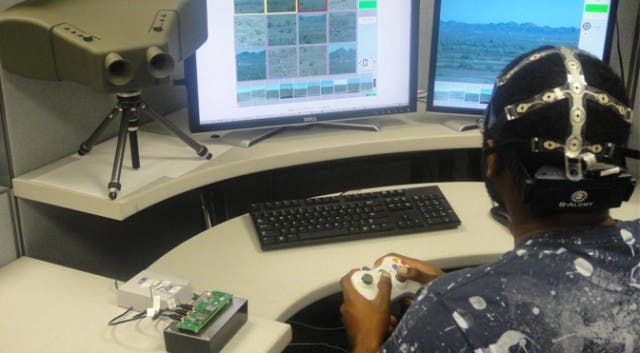Boy, oh boy. Here’s a run for your dollar – DARPA’s latest ultimate threat detection system seems like it’s stripped from a bad war movie, but crazy as it may sound, it works and very well, according to officials.
The system, called Cognitive Technology Threat Warning System (CT2WS), consists of an extremely high resolution camera of 120-megapixels, which captures its surroundings. These images are then fed to a supercomputer which runs cognitive visual processing algorithms, on the lookout for threats like a sniper scope or a camouflaged tank nozzle. The output is then interfaced through a display where a soldier is stationed, tasked with confirming these threats. The soldier, however, has an EEG (electroencephalogram) strapped to his scalp.

As the soldier’s brain rules out threats, the brain signals are registered by the EEG and then processed. With enough data to make it statistically viable, the system will soon be able to accurately detect threats on its own. Spotting threats is tiresome, but with such a system already built-in for a scout helicopter or directly in the headset display of a foot-soldier, these could be interfaced terminator-style.
“DARPA set out to solve a common challenge for forward troops: how can you reliably detect potential threats and targets of interest without making it a resource drain?” said Gill Pratt, DARPA program manager. “The prototype system has demonstrated an extremely low false alarm rate, a detection rate in the low nineties, all while reducing the load on the operator.”
The whole system works around our brain’s P300 response – a signal triggered when your brain recognizes something important. This can be a face, a football or a threat, doesn’t really matter. Your brain is wired to recognize familiar features, especially when they’re out of place with the scenery. No computer can recognize patterns, spatial ones especially, like the human brain, and by correlating data gathered by human intervention the system learns along, becoming smarter and smarter.
In tests so far, the system generated 810 false alarms per hour. That may seem like much, but according to DARPA the human operator can handle the 10 images per second it’s fed by the CT2WS display. Overall accuracy of the system is 91%, but expect it to improve as it moves past the prototype phase.
Was this helpful?



